Gennady’s Bible
Gennady’s Bible
by Viktoria Malik
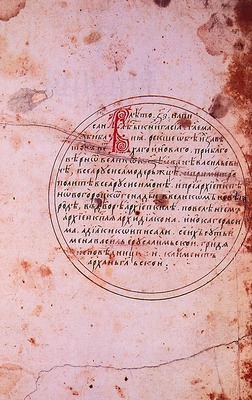
- Author of the project: Archbishop Gennady
- Title: The complete corpus of Old and New Testaments
- Date: 1480-1499
- Edition: Novgorod scriptorium
- Pages: 1007 folio leaves
- Language: Old Church Slavonic
- Source: Partial reprint of Gennady’s Bible online, State Historical Museum in Moscow
Purpose
With a view to create the first complete version of the Old and New Testaments translated into Church Slavonic, the archbishop Gennady of Novgorod organized a search for the existing parts of the translated Bible, located in the neighbouring monasteries and cathedrals.
Formal aspects
Gennady’s Bible does not have any extensive decorations or illustrations except for the red initials and headbands at the beginning of different chapters and a miniature of Moses on the first sheet of pagination. Perhaps, this is because the main purpose of Gennady’s Bible was to unite all the translations and to add the missing ones within the rather limited time frame.
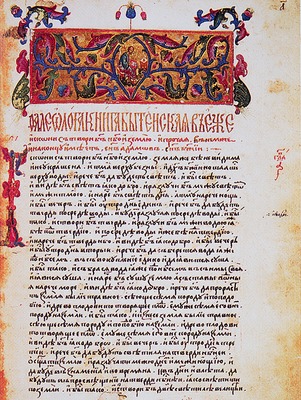
Value given to the edition
The two-column and full-page layout, elegant small type, and page decorations, taken from Gennady’s Bible, were the basis for Ivan Fedorov’s first printed Bible in Old Church Slavonic, as well as of most of the Christian Orthodox Bibles printed up to the present day.
This Bible represents a curious mixture of different translations. In addition to the basic Biblical texts in the ancient Greek translation, Gennady’s Bible contained additional parts in the new translation from other languages, including 1) the preface and explanatory notes to the Biblical books, partly translated from the German Bible, partly from the Latin Vulgate, 2) a number of non-canonical and partly canonical Biblical books and parts of books translated from Latin.
Political value
Supposedly, the creation of the complete Bible translation was prompted by Archbishop Gennady’s struggle against the “Judaic heresy” and therefore, the consolidation of his Church.
We can also explain the need to create a unified translation of the Bible by the general convenience of having a complete edition of this text in one language, accessible to all the clergy and literate people of the state — having different parts of the Bible in different regions risked to lead the clergy to the general misunderstanding and diverging interpretations of the book.
The last decades of the 15th century in the Russian history mark the end of the Mongol-Tatar invasion to the Kievan Rus and the annexation of the Kingdom of Novgorod (1478) by Moscow. Centralization around the Kingdom of Moscow laid the groundwork for formation of the Russian state; and a complete Bible in Russified Old Church Slavonic could play a role of a unifying symbol of the new consolidating country.
The choice of the Kingdom of Novgorod to gather and unify the whole Bible in Old Church Slavonic shortly after the kingdom’s conquest by Moscow was also a political gesture, implying the reconciliation between the states, the submission of Novgorod, and the oblivion of its separatist sentiments.
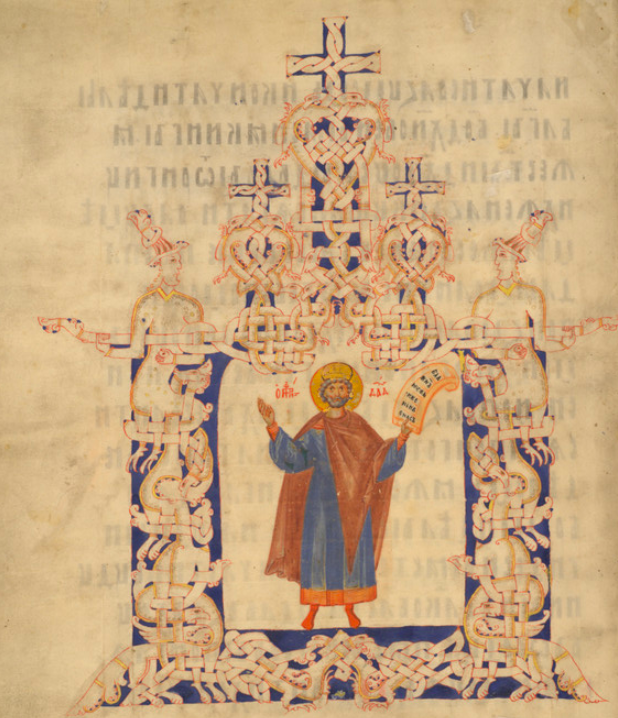
Image of Christ and King David in the Christian Orthodox tradition
The personal psalter of tsar Ivan the Terrible (mid-late 16th) also looks surprisingly humble although we see there several decorated and multicolored initials, three headbands and two full-page miniatures. One of them depicts King David (sheet 38) holding a scroll with psalms. David is placed in a very curious frame with anthropomorphous interlacing figures of humans with birds’ legs. Two mirrowing figures on the top sides of the frame are connected with a lace that resembles a musical instrument with two ends and the figures’ gestures look as if these characters are playing these instruments.
In tsar Boris Godunov’s Psalter (1594), we read the psalm 22 with a marginal image of Christ enthroned, holding the Bible with one hand and blessing with another.
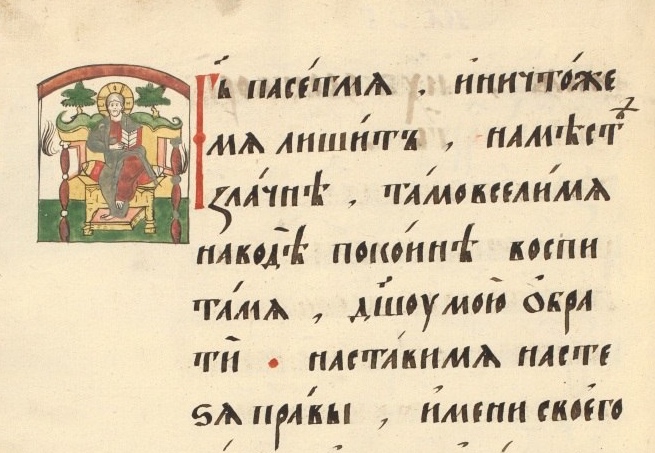
Another rare example of an illustrated Psalter is from the first decades of the 16th century. This copy has multiple full-page miniatures and wide illustrations on the margins almost of all pages. King David appears there several times, including in the miniature where he is depicted praying to God in church, with God himself blessing the king from the sky.
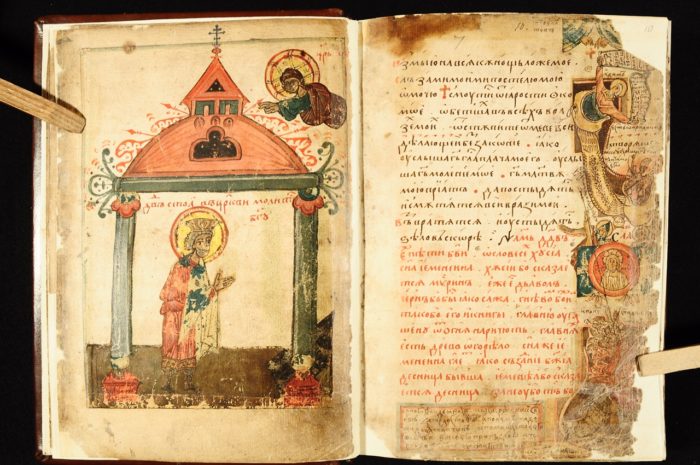
None of the aforementioned Bibles and Psalters have an image of Christ as a young man or as a shepherd. Neither there are images of King David as a young man, a musician, or a warrior. Such representations of Christ and King David are generally uncommon in Orthodox Christian art.
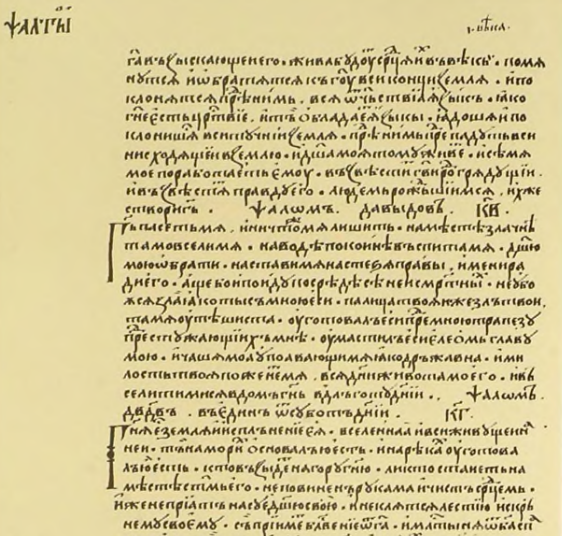
| Old Church Slavonic transcribed | Contemporary Russian | English translation |
| Госпо́дь пасе́т мя́ и ничто́же мя́ лиши́т. | Господь — Пастырь мой; я ни в чем не буду нуждаться: | The Lord is my shepherd, I lack nothing. |
| На ме́сте зла́чне, та́мо всели́ мя́, на воде́ поко́йне воспита́ мя́. | Он покоит меня на злачных пажитях и водит меня к водам тихим, | He makes me lie down in green pastures, he leads me beside quiet waters, |
| Ду́шу мою́ обрати́, наста́ви мя́ на стези́ пра́вды, и́мене ра́ди Своего́. | подкрепляет душу мою, направляет меня на стези правды ради имени Своего. | he refreshes my soul. He guides me along the right paths for his name’s sake. |
| А́ще бо и пойду́ посреде́ се́ни сме́ртныя, не убою́ся зла́, я́ко Ты́ со мно́ю еси́: | Если я пойду и долиною смертной тени, не убоюсь зла, потому что Ты со мной; | Even though I walk through the darkest valley, I will fear no evil, for you are with me; |
| же́зл Тво́й и па́лица Твоя́, та́ мя́ уте́шиста. | Твой жезл и Твой посох — они успокаивают меня. | your rod and your staff, they comfort me. |
| Угото́вал еси́ пре́до мно́ю трапе́зу сопроти́в стужа́ющым мне́, | Ты приготовил предо мною трапезу в виду врагов моих; | You prepare a table before me in the presence of my enemies. |
| ума́стил еси́ еле́ом главу́ мою́, и ча́ша Твоя́ упоява́ющи мя́, я́ко держа́вна. | умастил елеем голову мою; чаша моя преисполнена. | You anoint my head with oil; my cup overflows. |
| И ми́лость Твоя́ пожене́т мя́ вся́ дни́ живота́ моего́; | Так, благость и милость <Твоя> да сопровождают меня во все дни жизни моей, | Surely your goodness and love will follow me all the days of my life, |
| и е́же всели́ти ми́ ся́ в до́м Госпо́день в долготу́ дни́й. | и я пребуду в доме Господнем многие дни. | and I will dwell in the house of the Lord forever. |
The modern Russian translation is identical to its English alternative. There are a few textual changes in Old Church Slavonic and modern Russian and therefore English. For instance, the original psalm starts with “Госпо́дь пасе́т мя́ и ничто́же мя́ лиши́т” meaning “the Lord herds me, he won’t deprive me of anything” instead of more laconic “The Lord is my shepherd, I lack nothing”. This translation shifts subjectivity and thus agency to David / the person who pronounces the prayer whereas the medieval version gives all the possible power to the Lord.
The significant grammatical and textual changes to the Old Church Slavonic version of the text appeared in the 18th century (Elizabethan Bible) and then, in the 19th and 20th centuries. The psalm’s version in Gennady’s Bible appears to stay unchanged since the first translation of the Psalter from Greek in the 9th century.
Bibliography
Alexeyev, Gennady’s Bible. Textology of a Slavic Bible, November 30, 2021, http://ksana-k.narod.ru/Book/alekseev/02/76.htm.
Christian Orthodox Encyclopedia, Gennady’s Bible, November 2, 2021, https://www.pravenc.ru/text/162049.html.
Romodanovskaya, “Gennady’s Bible: Goals and Principles of the edition”, October 20, 2021, http://odrl.pushkinskijdom.ru/LinkClick.aspx?fileticket=y5y81-EJK2w%3D&tabid=8102.
Romodanovskaya, “Notes on translation of ”Latin” books of Gennady’s Bible”, November 10, 2021, http://ksana-k.narod.ru/Book/alekseev/02/76.htm



